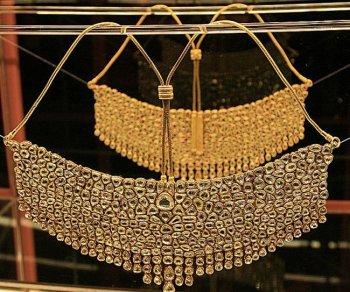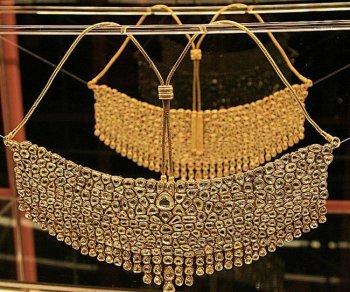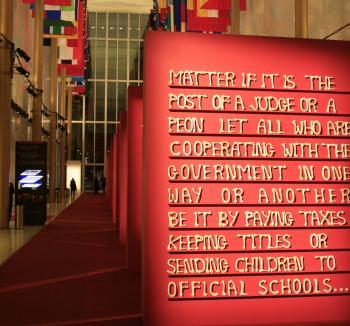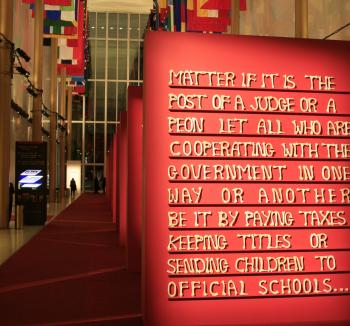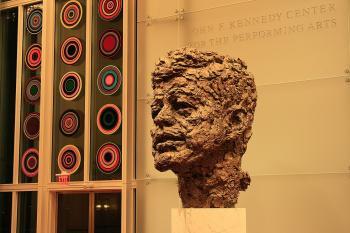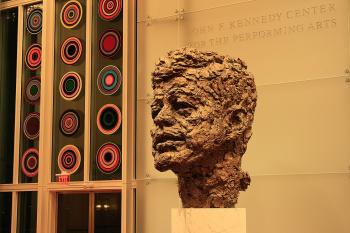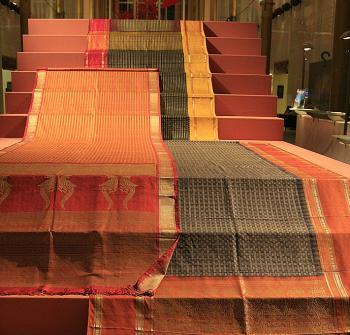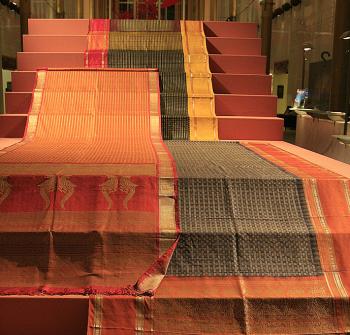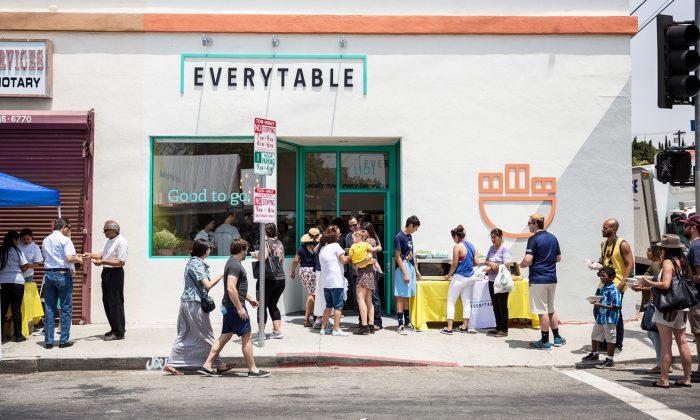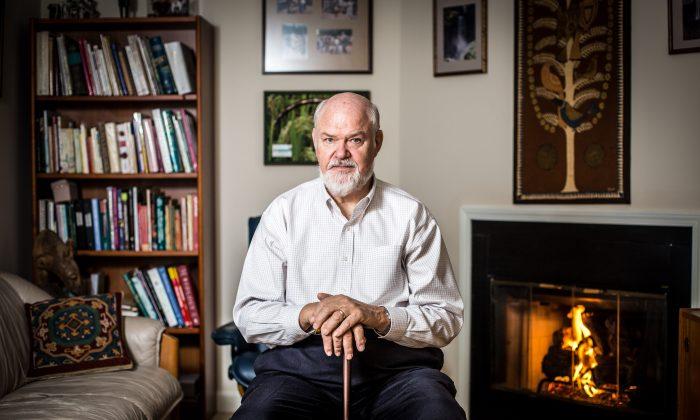WASHINGTON—The Kennedy Center Opera House has outdone itself with an all-new cultural festival honoring the world’s largest, oldest, and most eclectic democracy.
“Maximum India” features some of that country’s best performers, artists, intellectuals, filmmakers, writers, and chefs in a classy, jam-packed, three-week offering March 1–20.
Free exhibits and performances are in the Eisenhower Theater and Millennium stages. Tickets are available for select venues, such as the Monsoon Club, which has been fashioned by Mumbai’s famous club designer, Kapil Gupta, into a three-dimensional carpet of 500,000 raindrops frozen in space.
Visitors may see the essence of India in all of its extravagance as well as its historical depth. See yards of kaleidoscopic woven saris, thousands of artistically-rendered bindis flowing up the windows of the Grand Foyer, ancient-inspired royal wedding jewelry from Jaipur’s Gem Palace, and oversized tablets showcasing Mahatma Gandhi’s Salt March speech.
Bring children to visit an interactive, fun and fact-filled exhibit, and reserve your appetite to enjoy India’s sensual flavors, served up by no less than 13 top chefs specializing in various regional cuisines.
Maximum India’s curators made eight trips, and spent $7 million to get their inspiration of bringing the highest quality artists to the nation’s capital. The result is over 500 performers, who, together, reflect modern India’s fusion of global influences and age-old traditions.
Visitors must be quick to investigate the schedule of events in depth and get down to the center, because there are no repeat performances. For those unfamiliar with Indian culture, know that these acts are truly impressive. Investigate and prepare yourself to learn about this great culture.
Consider Parikrama, a rock band influenced by Led Zeppelin and Jimi Hendrix that uses traditional Indian instruments to produce its sound (March 11).
“Maximum India” features some of that country’s best performers, artists, intellectuals, filmmakers, writers, and chefs in a classy, jam-packed, three-week offering March 1–20.
Free exhibits and performances are in the Eisenhower Theater and Millennium stages. Tickets are available for select venues, such as the Monsoon Club, which has been fashioned by Mumbai’s famous club designer, Kapil Gupta, into a three-dimensional carpet of 500,000 raindrops frozen in space.
Visitors may see the essence of India in all of its extravagance as well as its historical depth. See yards of kaleidoscopic woven saris, thousands of artistically-rendered bindis flowing up the windows of the Grand Foyer, ancient-inspired royal wedding jewelry from Jaipur’s Gem Palace, and oversized tablets showcasing Mahatma Gandhi’s Salt March speech.
Bring children to visit an interactive, fun and fact-filled exhibit, and reserve your appetite to enjoy India’s sensual flavors, served up by no less than 13 top chefs specializing in various regional cuisines.
Maximum India’s curators made eight trips, and spent $7 million to get their inspiration of bringing the highest quality artists to the nation’s capital. The result is over 500 performers, who, together, reflect modern India’s fusion of global influences and age-old traditions.
Visitors must be quick to investigate the schedule of events in depth and get down to the center, because there are no repeat performances. For those unfamiliar with Indian culture, know that these acts are truly impressive. Investigate and prepare yourself to learn about this great culture.
Consider Parikrama, a rock band influenced by Led Zeppelin and Jimi Hendrix that uses traditional Indian instruments to produce its sound (March 11).
Or learn about a few of India’s traditional dance forms:
Go to Shantala Shivalingappa, a dancer and choreographer specialized in “kuchipudi,” a 2,000-year-old dance form known for its graceful movements and strong drama (March 12).
Or see Sharmila Biswas, from Odissi Vision and Movement Centre, dancing the most ancient of Indian dance forms, the “odissi” dance (March 14).
Include Kerala Kalamandalam Kathakali Troupe, specializing in the stylized dance drama “kathakali” (March 19).
The festival celebrates women in film. A panel discussion on March 15 features some of India’s brightest in conversation with the audience.
Famous Indian intellectual voices, like Booker Prize winner Salman Rushdie, Nayantara Sahgal, and William Dalrymple, will discuss the roles of history, politics, gender, class, and caste (March 18).
In the performance art component, consider seeing one of India’s most famous actresses Shabana Azmi, starring in the play, “Broken Images,” a story about a Hindi short-story writer who ends up penning a bestseller in English (March 16).
After spending a couple of hours with the exhibits or taking in a performance, your mind should be swirling with sights and sounds. By this point, the fragrant spices wafting from the Roof Terrace Restaurant, and the KC Cafe will have awakened your taste buds, and you should take heed.
The Kennedy Center has brought in super-chef, Hemant Oberoi, the executive chef of India’s Taj Mahal Hotels, to transform its restaurants into authentic, Indian eateries.
Oberoi, a personal chef to prime ministers and dignitaries like Barack and Michelle Obama, who overseas a team of 1,000 chefs, 23 hotels, and 170 restaurants around the world, was given the task of recreating India’s eclectic cuisine in Washington.
Go to Shantala Shivalingappa, a dancer and choreographer specialized in “kuchipudi,” a 2,000-year-old dance form known for its graceful movements and strong drama (March 12).
Or see Sharmila Biswas, from Odissi Vision and Movement Centre, dancing the most ancient of Indian dance forms, the “odissi” dance (March 14).
Include Kerala Kalamandalam Kathakali Troupe, specializing in the stylized dance drama “kathakali” (March 19).
The festival celebrates women in film. A panel discussion on March 15 features some of India’s brightest in conversation with the audience.
Famous Indian intellectual voices, like Booker Prize winner Salman Rushdie, Nayantara Sahgal, and William Dalrymple, will discuss the roles of history, politics, gender, class, and caste (March 18).
In the performance art component, consider seeing one of India’s most famous actresses Shabana Azmi, starring in the play, “Broken Images,” a story about a Hindi short-story writer who ends up penning a bestseller in English (March 16).
After spending a couple of hours with the exhibits or taking in a performance, your mind should be swirling with sights and sounds. By this point, the fragrant spices wafting from the Roof Terrace Restaurant, and the KC Cafe will have awakened your taste buds, and you should take heed.
The Kennedy Center has brought in super-chef, Hemant Oberoi, the executive chef of India’s Taj Mahal Hotels, to transform its restaurants into authentic, Indian eateries.
Oberoi, a personal chef to prime ministers and dignitaries like Barack and Michelle Obama, who overseas a team of 1,000 chefs, 23 hotels, and 170 restaurants around the world, was given the task of recreating India’s eclectic cuisine in Washington.
Next: Showcasing India on a Platter
“We wanted to showcase India on a platter—every corner of India is being represented,” said Oberoi.
To create the over 350 dishes showcased at the festival, Oberoi brought 12 specialists from the south, north, east and west of India. He brought over his own personal spices to ensure the quality and freshness of his signature masala blends.
Oberoi, who has just released his first book, “The Masala Art: Indian Haute Cuisine,” trained first in French cooking, but is now world-renowned for his innovative approach to traditional Indian culinary styles.
“I will never touch the flavors of the traditional dishes. It has to be that way; it can be presented in a different way, but don’t mess up the flavors. Somebody did a lot of work for it,” said Oberoi.
Visitors may delight in the rich jewels of India’s famous Gem Palace, which reflects a legacy of eight generations of the Kasliwal family of Jaipur, India.
“My family was the official jeweler to most of the Indian royalty,” said Mannu Kasliwal, the lead designer of the million-dollar collection on display at the Kennedy Center.
“These pieces have been created recently in our original workshops using the traditional craftsman,” said Kasliwal, who is clearly in love and awe of his collection of old rose cut diamonds and other precious stones.
“Jewelry is something that lives beyond us, so it has to be perfect from every angle. Because it is something that is passed from one generation to the next,” said Kasliwal.
The Kasliwal family gems have been showcased five times at the Metropolitan Museum of Art, and Americans may see a selection at Barneys New York.
To create the over 350 dishes showcased at the festival, Oberoi brought 12 specialists from the south, north, east and west of India. He brought over his own personal spices to ensure the quality and freshness of his signature masala blends.
Oberoi, who has just released his first book, “The Masala Art: Indian Haute Cuisine,” trained first in French cooking, but is now world-renowned for his innovative approach to traditional Indian culinary styles.
“I will never touch the flavors of the traditional dishes. It has to be that way; it can be presented in a different way, but don’t mess up the flavors. Somebody did a lot of work for it,” said Oberoi.
Visitors may delight in the rich jewels of India’s famous Gem Palace, which reflects a legacy of eight generations of the Kasliwal family of Jaipur, India.
“My family was the official jeweler to most of the Indian royalty,” said Mannu Kasliwal, the lead designer of the million-dollar collection on display at the Kennedy Center.
“These pieces have been created recently in our original workshops using the traditional craftsman,” said Kasliwal, who is clearly in love and awe of his collection of old rose cut diamonds and other precious stones.
“Jewelry is something that lives beyond us, so it has to be perfect from every angle. Because it is something that is passed from one generation to the next,” said Kasliwal.
The Kasliwal family gems have been showcased five times at the Metropolitan Museum of Art, and Americans may see a selection at Barneys New York.
Its jewels have been sought by famous figures such as Richard the Lionheart, the Rockefeller family, Jackie Onassis, and the late Princess Diana.
For those who are struck by the brilliance of these jewels, and can’t wait to get their hands on a piece, a boutique in the Nations Gallery offers a small selection for sale.
All exhibitions are open daily, from 10 a.m. to 10 p.m. For a complete schedule of events, visit www.kennedy-center.org
For those who are struck by the brilliance of these jewels, and can’t wait to get their hands on a piece, a boutique in the Nations Gallery offers a small selection for sale.
All exhibitions are open daily, from 10 a.m. to 10 p.m. For a complete schedule of events, visit www.kennedy-center.org
